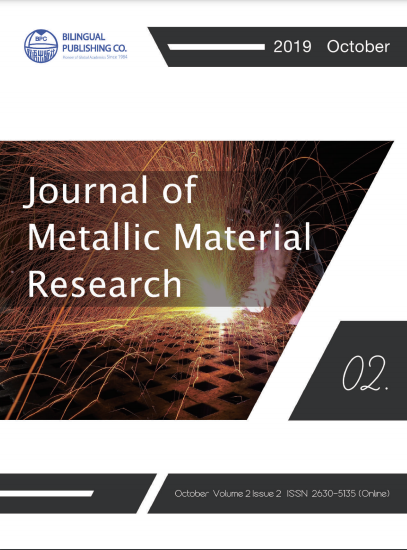-
188
-
175
-
137
-
124
-
92
Stereological Evaluation of Precipitates within Ferrite Grains in Heat-Treated 1.25Cr0.5Mo Steel Previously Exposed to Service
DOI:
https://doi.org/10.30564/jmmr.v2i2.1017Abstract
The objective of this work was to study the effect of the heat treatment and further operation aging on the stereological parameters (size, quantity and volume fraction) of precipitates within ferrite grains of a creep-resistant 1.25Cr0.5Mo steel after long-term operation. The heat treatment was similar to the treatment that is carried out in industrial steam pipelines after welding (post weld heat treatment - PWHT) during installation and/or repairing. The operation aging corresponds to a subsequent long in-service operation after repairing. To determine the stereological parameters, SEM digital images were taken from samples of this material after conditions of in-service-aged (after long-term operation), in-service-aged and heat-treated (simulating repairing) and in-service-aged, heat-treated and in-laboratory aged (simulating subsequent long-term operation after repairing). The results indicate that the changes in the stereological parameters of the precipitates within ferrite grains after PWHT is associated with the coarsening process of the within-ferrite-grain precipitates as well as stabilizing the microstructure, since the material aging after PWHT of an in-serviced aged material would not change the stereological parameters.
Keywords:
Creep-resistant 1.25Cr0.5Mo Steel; Repairing; PWHT; Precipitation coarseningReferences
[1] E. Keim, D. Lidbury, Review of assessment methods used in nuclear plant life management, NULIFE Report. 2012, 12 (5): 70-81.
[2] G. Rigueira, H. Furtado, M. Lisboa, L. Almeida, Microstructural evolution and hardness changes in bainite and pearlite in Cr1Mo 2.25 steels after aging treatment. Revista Matéria, 2011, 16 (4): 857-867. DOI: https://doi.org/10.1590/S1517-70762011000400007
[3] F. Abe, Precipitate design for creep strengthening of 9% Cr tempered martensitic steel for ultra-supercritical power plants, Science and Technology of Advanced Materials, 2008, 9 (1): 1-15. DOI: https://doi.org/10.1088/1468-6996/9/1/013002
[4] F. Larson, J. Miller, A time-temperature relationship for rupture and creep stresses. Transactions of the ASME, 1952, 74: 765-775.
[5] H. Furtado, F. Santos, B. Cardoso, F. Matt, L. Henrique, Power plant remaining life evaluation. Key Engineering Materials, 2014, 588 (10-11): 232-242.
[6] K. Laha, S. Chandravathi, P. Parameswaran, S. Bhanu, S. Rao, L. Mannan, Type IV cracking in modified 9Cr-1Mo steel weld joint. Metallurgical and Materials Transactions A, 2007, 38 (1): 58-68. DOI: https://doi.org/10.1080/09603409.2015.1137158
[7] A. Fernández, N. Alcãntara, S. Haro, I. López, Effect of in service weld repair on the performance of CrMo steel steam pipelines. Materials Research, 2006, 9 (2): 153-158. DOI: https://doi.org/10.1590/S1516-14392006000200008
[8] G. Eggeler, Microstructural parameters for creep damage quantification. Acta Metallurgica et Materialia, 1991, 39 (2): 221-231. DOI: https://doi.org/10.1016/0956-7151(91)90270-B
[9] Y. Kadoya, E. Dyson, M. McLean, Microstructural stability during creep of Mo- or W-bearing 12Cr steels. Metallurgical and Materials Transactions A. 2002, 33 (8): 2549-2557. DOI: https://doi.org/10.1007/s11661-002-0375-z
[10] C. Lima, L. Pinto, L. de Almeida, Microstructural evolution of Cr-Mo ferritic steel (2,25Cr-1Mo) on long term high temperature operation - precipitates fraction calculation. In: 5th Brazilian MRS Meeting. Florianópolis, Brazil, 2006.
[11] X. Yu, S. Babu, H. Terasaki, Y. Komizo, Y. Yamamoto, M. Santella, Correlation of precipitate stability to increased creep resistance of Cr–Mo steel welds. Acta Materialia, 2013, 61 (6): 2194-2206. DOI: https://doi.org/10.1016/j.actamat.2012.12.040
[12] H. Furtado, I. Le May, High temperature degradation in power plants and refineries. Materials Research, 2004, 7 (1): 103-110. DOI: https://doi.org/10.1590/S1516-14392004000100015
[13] C. Lima, L.Pinto, H. Furtado, L. de Almeida, M. de Souza, I. Le May, Quantitative observations of precipitation in 2.25Cr–1Mo steel exposed to different creep conditions in a power station. Engineering Failure Analysis, 2009, 16 (5): 1493-1500. DOI: https://doi.org/10.1016/j.engfailanal.2008.09.009
[14] American Society for Testing and Materials. ASTM A335: Standard Specification for Seamless Ferritic Alloy-Steel Pipe for High-Temperature Service. ASTM International, West Conshohocken, PA, 2011.
[15] American Society of Mechanical Engineers. ASME Boiler and Pressure Vessel Code. Section VIII. Division 1. Rules for Construction of Pressure Vessels. ASME, 2010.
[16] American Society for Testing And Materials. ASTM E3-11: Standard Guide for Preparation of Metallographic Specimens, ASTM International, West Conshohocken, PA, 2011.
[17] American Society for Testing And Materials. ASTM E407-11: Standard Practice for Microetching Metals and Alloys, ASTM International, West Conshohocken, PA, 2011.
[18] P. Di Nunzio, H. Hougardi, Y. Lan, Modelling of particle growth and application to the carbide evolution in special steels for high temperature service.In: EUR 18633 — Properties and in-service performance. Luxembourg. 1999: 195. ISBN: 9789282850442
[19] Y. Endo, Estimate of confidence intervals for geometric mean diameter and geometric standard deviation of lognormal size distribution. Powder Technology, 2009, 193 (2): 154-161. DOI: https://doi.org/10.1016/j.powtec.2008.12.019
[20] R. Sultan, S. Ahmad, Comparison of parameters of lognormal distribution based on the classical and posterior estimates. Journal of Modern Applied Statistical Methods, 2013, 12(2): 304-313. DOI: https://doi.org/10.22237/jmasm/1383279420
[21] K. Krishnamoorthy, T. Mathew, Inferences on the means of lognormal distributions using generalized p-values and generalized confidence intervals. Journal of Statistical Planning and Inference, 2003, 115 (1): 103-121 . DOI: https://doi.org/10.1016/S0378-3758(02)00153-2
[22] J. Yang, Y. Huang, C. Yang, L. Horng, Microestructural examination of 2.25Cr1Mo steel pipes after extended service. Materials characterization, 1993, 30 (2): 75-88 DOI: https://doi.org/10.1016/1044-5803(93)90011-j
[23] A. Afrouz, J. Collins, R. Pilkington, Microestructural examination of 1Cr0,5Mo steel during creep. Metals Technology, 1983, 10(1): 461-463, DOI: https://doi.org/10.1179/030716983803291569
[24] D. Baird, Strengthening mechanisms in ferritic creep resistant steels. In: Creep Strength in Steel and High Temperature Alloys. Proceedings... The Iron and Steel Institute, 1972: 207-216.
[25] D. Ouden Mathematical Modelling of Nucleating and Growing Precipitates: Distributions and Interfaces. Dissertation at Delft University of Technology. Netherlands, 2015.
Downloads
How to Cite
Issue
Article Type
License
Copyright © 2019 Rafael Fernández-Fuentes, Americo Scotti, Amado Cruz-Crespo, Roberto Silva González, Rafael Ariza Gonçalves, Nelson Guedes Alcântara

This is an open access article under the Creative Commons Attribution-NonCommercial 4.0 International (CC BY-NC 4.0) License.




 Rafael Fernández-Fuentes
Rafael Fernández-Fuentes





